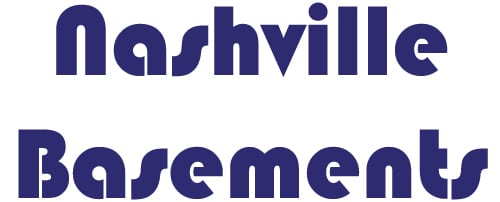Foundation Repair
Foundation repair contractors specialize in two main areas – first, settlement. With soil that is clay (often called plastic) with the change in moisture levels the soil expands and contracts. When this happens often a foundation will shift or settle. Evidence of this problem is usually observation by a homeowner of doors and windows that stick or become hard to open, visible cracks in mortar joints, separation of corners both interior on drywall and exterior. It is also common to see both vertical and horizontal cracks in a basement foundation wall. These are all signs of “vertical settlement”.
The second most common problem we see is bowing or buckling foundation walls. Whether your foundation was built with stone, block or poured concrete pressure on walls over time can cause movement. There are 4 common methods to address bowing basement walls that are discussed below.
How to fix a settling foundation
Piering is a process whereby a contractor digs a trench along the exterior (or interior) of the failing or settling wall. Then using steel piers we drive steel pipe into the ground to a depth that allows for stability when we attach the support bracket and raise or lift up the structure. Depending upon what areas have settled we install piers at distance apart that allows for proper load bearing based on the size and weight of the home or building. The piers are driven into the earth to a depth where we obtain proper load bearing strata. This depth varies depending upon the soil conditions of each geographic area.
Our crews are all certified and trained so you can rest assured they have the knowledge to do the work properly and efficiently. Learn more about their training and our patented piering systems, here.
Crawl Space Repair
Homes with vented dirt crawl spaces are susceptible to moisture, rodent and pests, mold, unnecessary loss of heating and cooling and most importantly poor air quality that emits into living space. To learn the history of how crawl spaces were designed and why encapsulation is the modern standard, click here.
Two types of Piers we Use for Vertical Settlement Repair:
Wet, leaky basements are very common in the Nashville area and all over Tennessee. You do not have to live with water coming into the basement when it rains. We offer over 50 different products that provide homeowners with peace of mind knowing they will have a “dry basement” regardless of how much rain there is during a storm. To learn “why basements leak” and how we can fix the problem permanently, click here.
Push Piers
Push piers are an economical and simple solution that can provide you with long lasting support. They are manufactured with industrial strength galvanized steel and have a very high resistance to corrosion to last for many, many years. The advantages of push piers are numerous:
- Can be installed year-round
- Piers reach greater depth than other options
- Long life span – galvanized steel is resistant to corrosion
- Does not require the use of invasive equipment
- In most cases can lift foundation back to level position
- Restores Property Value

Push pier installation process:
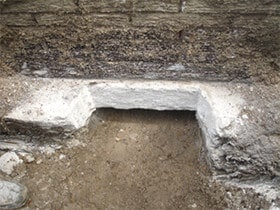
Step 1: The footing is exposed and prepared for the foundation bracket.
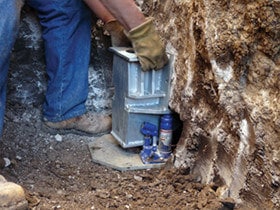
Step 2: The foundation bracket is secured to the exposed footing.
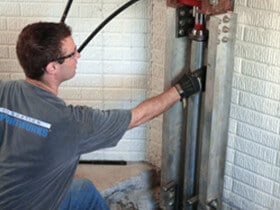
Step 3: Steel pier sections are hydraulically driven through the bracket to bedrock.
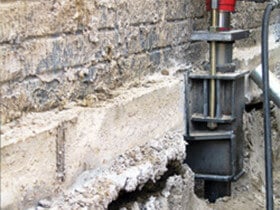
Step 4: The weight of the home is transferred through the piers to the bedrock and home is leveled.
Helical Piers
Helical piers are designed to efficiently stabilize settling foundations by transferring the weight of the home from the unstable ground to the piers which are driven down to load bearing earth. These piers are a faster solution to rebuilding the foundation. The advantages of helical piers are:
- Can be installed year-round
- Round shaft has a high resistance to bending
- Suitable for both heavy and light loads
- Long life span galvanized steel is resistant to corrosion
- Doesn’t rely on the weight of the structure for depth and capacity
- In most cases can lift foundation back to level position
- Restores Property Value
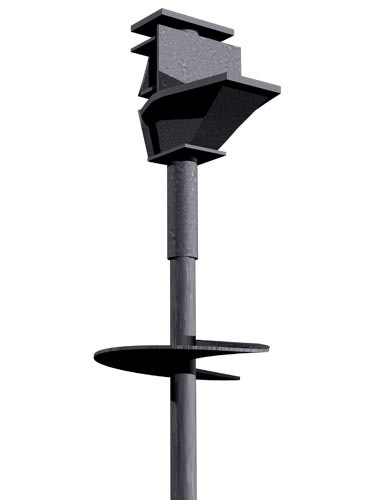
Helical pier installation process:
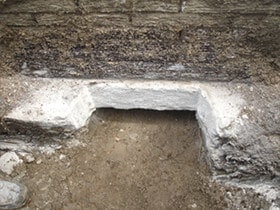
Step 1: The footing is exposed and prepared for the foundation bracket.
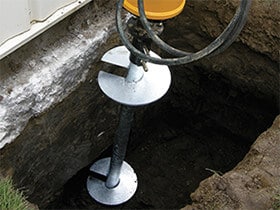
Step 2: The helical piers are mechanically driven into the soil.
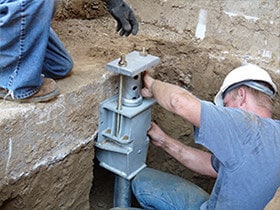
Step 3: Steel pier sections are hydraulically driven through the bracket to bedrock.
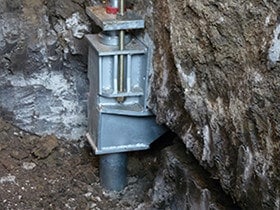
Step 4: The weight of the home is transferred through the piers to the bedrock and home is leveled.
Bowing or Buckling Basement Walls
Pressure or force on any type of foundation wall may cause a failure in the wall. When this occurs the most obvious symptom is sight observation where you see bowing inward or outward movement. Sometimes this happens when the soil expands and contractors and the weight of the building that sits on the walls exerts tremendous pressure. Another common reason is walls can deteriorate over time and become weak. Click here to view examples of what this problem looks like.
4 Methods to Fix a Bowed Wall
1. Replace – Some contractors will advise you to jack up your home, tear out the existing walls and build or pour new walls. This is the most expensive repair technique and is usually not necessary
2. Carbon Fiber – Strips of carbon fiber are adhered to the wall in order to stabilize any further movement. This method is best used when the wall has moved very little, however, it doesn’t straighten back the wall to its original position.
3. I Beams – In the past this method was commonly used. It doesn’t fix the problem and tends to add stability only where the beams are located so it may require a lot of beams making it cost prohibitive. In addition, it is unsightly especially in any type of finished basement.
4. Wall Anchors – This is the best solution in most instances. It is cost efficient and both straightens the walls and doesn’t ruin the aesthetics of the room. In addition, it is a patented and guaranteed method of repair. As an authorized Geo-Lock™ Wall Anchor System dealer we usually suggest this repair method. Here is how it works:
1Excavating the Foundation Perimeter
If the walls are dangerously damaged we may need to excavate around the perimeter of the foundation. This is done to relieve pressure placed on the foundation from exterior moisture and soil, this process is not necessary for all anchor installations. Notice the extreme bowing of the wall due to constant pressure from the soil.
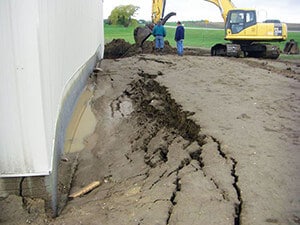
2Position the Anchor Plates
Outside the home a section of sod is carefully removed at the location of each anchor and a hole is dug for the anchor plate. The anchor plate is made of high quality galvanized steel to resist corrosion. These include a 25 year warranty against manufacturing defects. Each anchor plate has a hole for attaching an anchor rod that is installed in the next step.
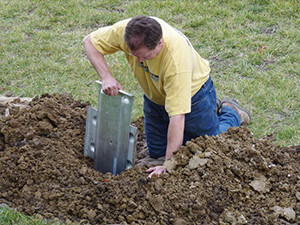
3Prepare the Foundation Wall
We drill a small hole in your foundation wall to insert the steel anchor rod that will connect the wall plate to the anchor plate. This rod is driven through the soil until it is attached to the anchor plate. One of the ways in which our anchor system is superior to other methods is the hole in the foundation wall is very small at 1 inch in diameter. Some other methods may require removal of blocks or large holes to be cut into the foundation.
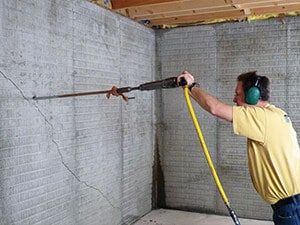
4Mount Wall Plates
Once the anchor plate has been connected to the anchor rod, a steel wall plate is mounted to the anchor rod inside the foundation walls. After installation, your walls will be secure. The wall plates will be tightened over time to straighten the foundation wall and continue to provide support.
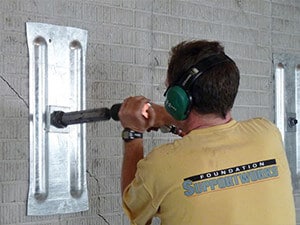
5Straighten Basement Walls
The tightening of the wall plates will continue until your foundation walls have been straightened to their original position. This happens over time and will provide long term support for your foundation walls. To avoid excess pressure from the soil, gravel and a drain tile system may be installed. The soil that was removed during excavation will be replaced and landscaping will be restored.
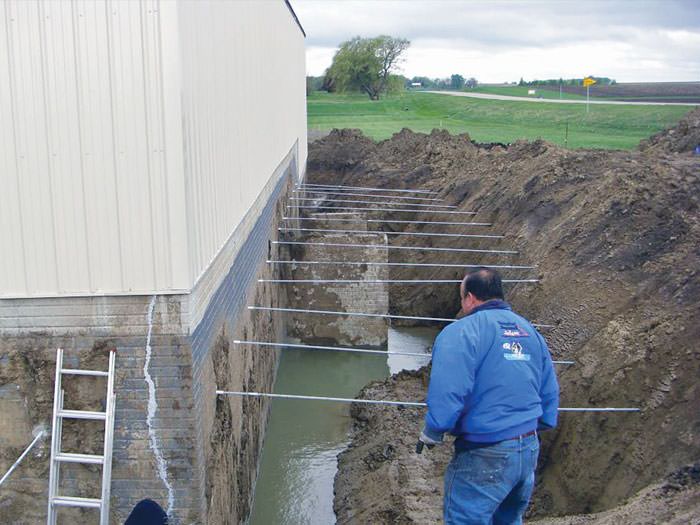
6Clean Up and Prepare for Finishing
Inside the home, the wall plates can be covered with our wall anchor covers to help them blend in with existing basement finishing decorations. Outside, the holes created will be carefully filled, compressed, and have sod replaced. Most anchor holes will blend seamlessly with the landscape.
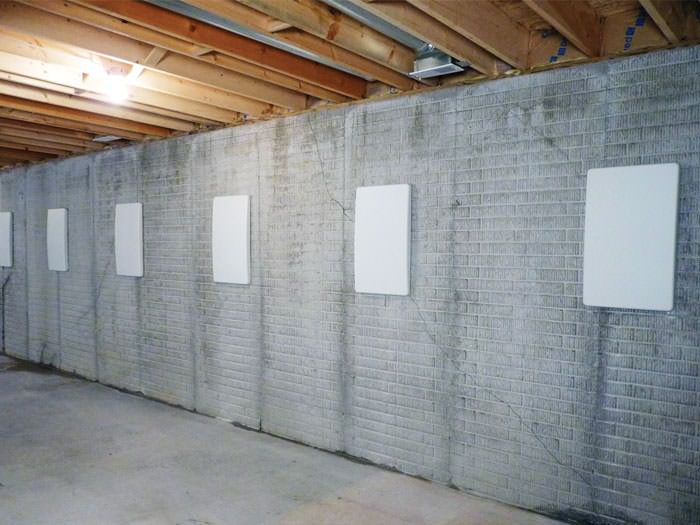
Nashville Basements offer both a free inspection and written analysis for any Nashville and 75 mile area homeowner with settlement concerns. Contact Us

